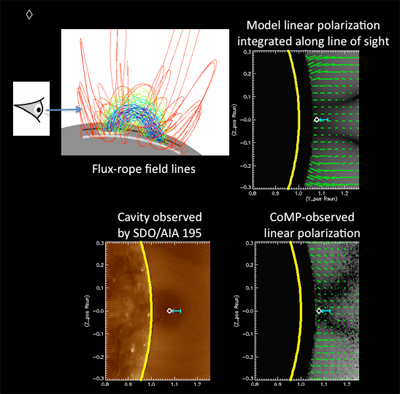Extracting clues from solar cavities
Will they provide insights for space weather prediction?
Oct 16, 2012 - by Staff
Oct 16, 2012 - by Staff
October 16, 2012 | Coronal mass ejections (CMEs) are powerful eruptions near the surface of the Sun that can disrupt satellites and power grids. Understanding what drives these space weather events may allow astronomers to predict impending CMEs so that appropriate measures could be taken to safeguard vulnerable technology on Earth. New observations by NCAR scientist Sarah Gibson of the Sun’s magnetic field and a phenomenon known as coronal cavities are providing an unprecedented glimpse into what triggers these massive eruptions.
Gibson and other solar scientists suspect CMEs are driven by a restructuring of the magnetic fields on the Sun. These magnetic fields can be twisted by movements of gas into “magnetic flux ropes” that can suddenly kink, much like a twisted rubber band or phone cord. Such kinks have the potential to release enough energy to hurl hot gas into space at incredible speeds.
Gibson and her colleagues are trying to determine if there is a stored-up twist in the corona—the tenuous million-degree plasma that envelops the Sun. “Is the magnetic field powered up and ready to go?” she asks. But this is a difficult question to answer, as the sparse solar corona, which has little material to emit light, cannot be easily observed.

Bottom left: An observation in the extreme ultraviolet portion of the light spectrum by NASA's Solar Dynamic Observatory on May 25, 2011. The approximate center of a low-density coronal cavity (white diamond) and its approximate radius (turquoise line) are indicated (courtesy NASA).
Bottom right: An observation on the same date by NCAR's CoMP instrument shows the Sun's magnetic signature. Researchers are studying the relationship between this magnetic behavior, the presence of low-density coronal cavities, and the likelihood of a coronal mass ejection. The team has dubbed the observed pattern the "bunny head," with the head indicating the suspected location of the cavity and the ears being an artifact of the way we view these polarized signals from Earth (courtesy NCAR High Altitude Observatory).
Top left: Modeled flux-rope field lines on the solar surface that provide an indication of how cavities within the corona may be aligned. The cartoon "eye" shows the line of sight from Earth (courtesy Yuhong Fan, NCAR).
Top right: The NCAR team's "forward model," predicting where a cavity will appear, matches well with the observation made by the CoMP instrument (courtesy Sarah Gibson, NCAR).
To tackle the question, Gibson and her team are using the NCAR-designed Coronal Multi-Channel Polarimeter instrument (CoMP), located within the center’s solar observatory on the summit of Hawaii’s Mauna Loa, to study coronal cavities—dark tunnels within the hot corona that precede a CME. Astronomers think these cavities are held in place by magnetic flux ropes, which resemble a stretched-out Slinky toy anchored to the Sun’s surface. By bringing improved detectors and analysis techniques to bear, NCAR scientists are, for the first time, able to map the magnetic field orientation within these cavities.
The new observations trace the magnetic field in and around coronal cavities. The images show field alignments very similar to the twisted flux ropes long believed to thread the cavities. Seeing such alignments days before a CME may help scientists predict an eruption.
The observations from CoMP are only a first step. To fully understand the magnetic dynamics that lead to CMEs, astronomers need to quantify the magnetic field in three dimensions and follow its evolution as it erupts. The Coronal Solar Magnetism Observatory telescope (COSMO), as proposed by NCAR and the universities of Michigan and Hawaii, would enable observations that will provide missing pieces of the puzzle, according to Gibson.
“Once we understand the three-dimensional magnetic field, we'll have far more answers,” Gibson says.
NCAR visiting scientist Urszula Bąk-Stęślicka is working with Gibson on a paper discussing their recent observations. Also see Gibson et al., 2010; Schmit and Gibson, 2011; Kucera, Gibson et al., 2012.